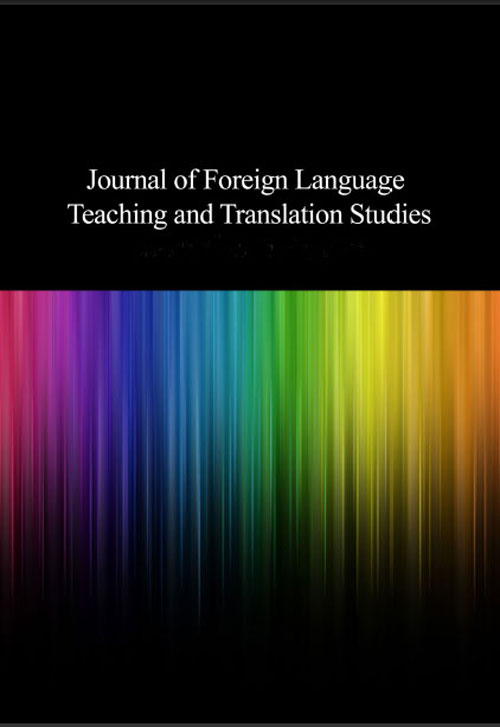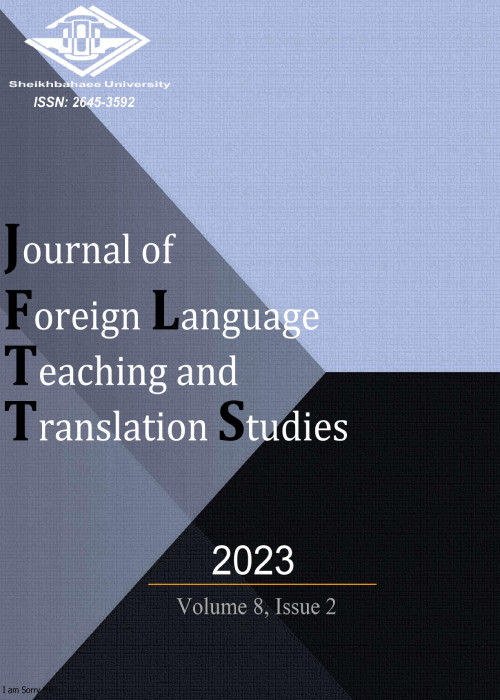فهرست مطالب

Journal of Foreign Language Teaching and Translation Studies
Volume:1 Issue: 1, Spring 2012
- تاریخ انتشار: 1396/06/30
- تعداد عناوین: 6
-
Page 1This paper aimed at probing the implementation of portfolio assessment in the writing classroom in an attempt to examine its effect(s) on EFL learners‟ metadiscourse awareness. It addressed the following questions: Does portfolio assessment as a teaching technique have positive wash back effect on the participants‟ achievement in their writing ability in an academic context? And to what extent do the students develop metadiscourse awareness in their writing by the treatment of portfolio assessment?
The participants were the students of English literature enrolled for their composition course. After being homogenized for their proficiency level, they were randomly divided into an experimental group (EG) and a control group (CG). As the treatment, portfolio assessment was employed as the teaching technique for the experimental group. Data was then subjected to different statistical procedures. The results of data analysis revealed that the participants in the EG outperformed those in the CG with regard to the achievement in their overall writing ability. Second, based on chi-square results, participants in the EG used metadiscourse markers more correctly and efficiently compared with those in the CG. The results of the present study may have some implications for teaching of writing to EFL learners.Keywords: Achievement, Metadiscourse knowledge, Portfolio assessment, Performance testing, Writing ability -
Page 2A longitudinal study was planned, and a scale was suggested for assessing EFL learners oral presentations. The scale had three major evaluation components: `Preparation, `Organization, and `Presentation. The students were informed about the rating scale against which their performances would be evaluated. Throughout the course each student had five performances on different occasions.
The results of the study indicated that: (a) significant improvement was observed in the learners performances, (b) ANOVA results indicated that the five performances were significantly different, (c) there were high correlations between each paired performances, and (d) the rating scale was a reliable and consistent measure by means of which the instructor could assess the students speaking ability.Keywords: Oral presentation, speaking skill, EFL learners, objective assessment, rating scale -
Page 3This study was undertaken to cast light over EFL learner's perception of culture. To that end, a group of English language learners was taught English through Interchange Series and their perception of culture was assessed using a researcher constructed questionnaire. The same questionnaire was also administered to the parents of the same learners to detect any probable differences. The results revealed that the EFL learners are largely distinct from their parents in perceptions of the designated cultural issues. While EFL learners were oriented towards Western Culture, their parents were lopsided towards domestic issues.Keywords: Interchange series, EFL, Culture, English language, Iranian learners
-
Page 4With day-increasing emphasis on communication as the chief objective of second language learning, willingness to communicate (hereafter WTC) has come into focus by many researchers, teachers, and foreign language institutes. Previous studies show that WTC is highly correlated with the two variables of perceived competence and communication apprehension. This study aimed to investigate the difference in WTC between male and female English major students at Khorasgan University, Iran. Firstly, 55 English major students were asked to respond to three questionnaires on WTC, perceived competence and communication apprehension. The data was analyzed using independent sample t-test. The results showed no significant difference between male and female students in WTC, perceived competence and communication apprehension. The results related to the effect of language proficiency on WTC, perceived competence, and communication apprehensions were also analyzed using one way ANOVA. The results showed no significant differences between the three different groups of students with different levels of language proficiency in their WTC, perceived competence, and communication apprehension.Keywords: willingness to communicate, perceived competence, communication apprehension
-
Page 5The major role of self-directed learning (SDL) in a successful learning at distance education has been confirmed by various studies. Although learners pass General English courses before studying any ESP courses at distance education of Iran, they usually lack the preliminary skills for independent language learning. The current study aimed to explore the effect of self-directed training (SDT) on ESP learners‟ self-directed learning readiness (SDLR). Eighty-six B.A students (19 male and 67 female) studying English for Economy and Management at Tabriz Payam-e-Noor University participated in this study. A demographic questionnaire and Guglielmino‟s (1978) self-directed learning readiness scale (SDLRS) were implemented to select the participants of the control and experimental groups. The experimental group was provided with SDT in three different stages a) an introduction to SDL, b) SDT workshop, and c) SDT pamphlet. Then, a post-test of SDLRS was given to the two groups. ANCOVA was applied to analyze the data. The results revealed that SDT could enhance ESP learners‟ SDLR. The findings imply that an appropriate training is needed to improve learners‟ SDLR. Higher levels of SDLR can contribute to a successful ESP learning at Payam-e-Noor University in Iran.Keywords: distance learning, ESP, self-directed learning, self-directed language learning, self-directed training
-
Page 6Having its roots in science, chaos theory‟ provides a new strategy to examine the disordered world of postmodern novels to find the hidden order underlying the apparent chaos. This study tries to clarify the ambiguous relation between Oedipa Maas, the Tristero system‟ and the Maxwell‟s Demon‟ in Thomas Pynchon‟s The Crying of Lot 49. Oedipa Maas, the main character of the novel is regarded as an everyman‟ type character who tries desperately to make sense of the signs and mysteries proliferating around her, but she can never fulfill her quest because she is trapped in a chaotic world where there are no stable values, friends or meanings. She feels separated from the world around her and longs to regain the stability she used to have before she started her task as the executrix‟ of her former lover‟s vast estate. She does not manage to find order‟ in the surrounding chaos, but applying the major tenets of chaos theory and examining concepts such as the butterfly effect‟, bifurcations‟, strange attractors‟, recursive symmetry‟ and entropy‟ , we can come to a better understanding of the order underlying the disordered world of the novel.Keywords: chaos theory, the butterfly effect, strange attractors, entropy, recursive symmetry, Maxwell‟s demon, Thomas Pynchon


